Welcome back to the third installment of our mythbusting series, where we break down legends in telecom pricing and see if they hold water. (Don’t miss our investigations on tall tales in local access budgeting and MPLS/DIA pricing lore.)
Today’s myth: Is it true that, while SD-WAN adds costs to your WAN, because it frees you to leave or minimize MPLS, you can cut WAN costs by more than half?
This is a common claim from SD-WAN evangelists. The allure of dramatically reducing your network spend is strong. But how true is it?
To find out, I’m going to take an MPLS-based network and run a few different scenarios that minimize or fully remove MPLS and add internet. Then, I’ll compare the network costs and see if any meet the 50% savings threshold.
The Network
I’m starting with a hypothetical network that reflects real network topologies we’ve seen from our WAN Cost Benchmark customers and WAN Manager Survey participants. You can read the full process for creating the model here. In summary:
- The network has 150 sites globally with a concentration in North America and Western Europe.
- It’s running MPLS VPNs at 140 sites, dedicated internet access (DIA) at 25, and business broadband at 15.
- It has MPLS class of service (CoS) levels set to 10% voice/video, 30% real-time data, and 60% best efforts.
- This network has port/circuit speeds concentrated in the 11-50 Mbps bracket, with the majority of ports in that range at 20 Mbps. The next largest group is 5-10 Mbps.
- It has an average total available bandwidth—including any sites with two active network products added together—across all sites of 125 Mbps of active available capacity.
Our Starting Point
Original MPLS WAN Site Capacity Range
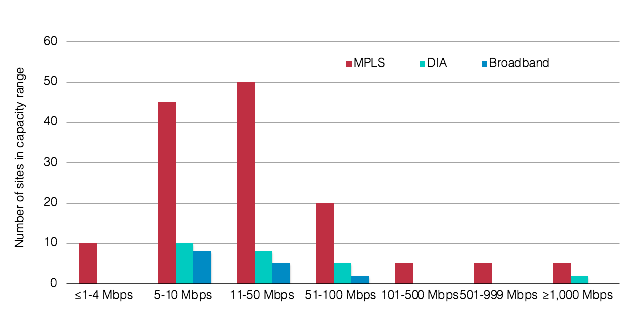
Original MPLS WAN Average Total Site Capacity by Subregion

All in all, this hypothetical network’s yearly total cost of ownership (TCO) sits around $6 million.
Now that we’ve got our baseline, let’s see how bandwidth and network cost changes as we substitute MPLS for DIA and business broadband.
Minimizing MPLS
Some WAN managers want to capture the savings, bandwidth increase, and flexibility of internet-based WAN without sacrificing the security and reliability of MPLS for their most important offices (HQ, data center). For them, we’ve created the MPLS-core network design.
To model the MPLS-core, our hypothetical scenario kept MPLS at the 13 sites where MPLS ports were >100 Mbps. All other sites are a DIA-broadband hybrid.
We generally kept a DIA port that is at least the size of the original MPLS port, as well as a matching (or larger) broadband circuit. We included 35 sites with broadband circuits in the 51-100 Mbps range.
How does bandwidth change when you keep MPLS at only core sites?
MPLS-Core DIA-Broadband Hybrid WAN Site Capacity Range
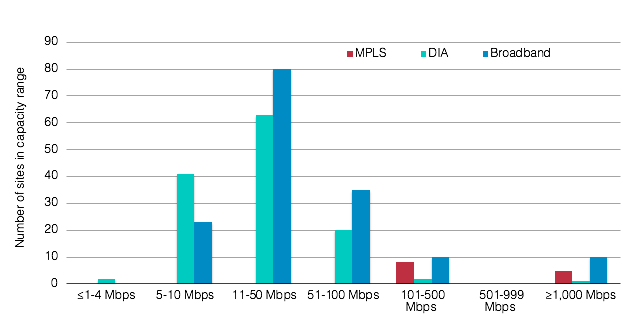
MPLS-Core DIA Broadband Hybrid WAN Average Total Site Capacity by Subregion
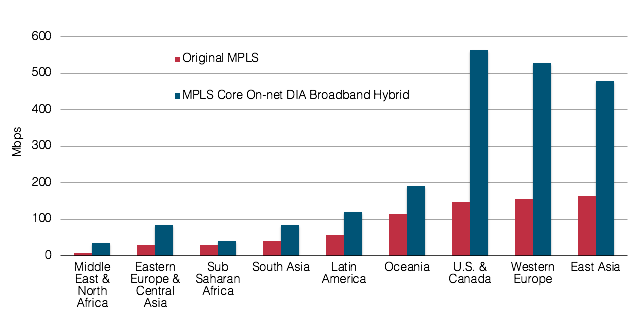
The resulting network has a global average of 420 Mbps available per site, which is a significant increase over the original 125 Mbps. This average is pulled up by regions in which there are offices and data centers containing very large ports and circuits. Much of the net capacity increase was in the U.S. & Canada, Western Europe, and East Asia, where the majority of bigger sites are located.
Going All Internet
Time to scrap that last bit of MPLS and substitute it with more DIA and broadband.
If the prospect of giving up all carrier guarantees in the WAN is too much, a network manager might opt to mix uncontended, SLA-protected DIA with business broadband. One of the scenarios we tested is a DIA-business broadband hybrid. This network had the following assumptions:
- The network is almost identical to the MPLS-core hybrid, simply with all the remaining large-capacity MPLS ports switched to DIA.
- As with the MPLS-core network, the average capacity per site is 420 Mbps, a 236% increase over the original MPLS WAN.
- As with all the other hypothetical networks, 11-50 Mbps is the most typical port/circuit capacity range.
- All subregions saw a significant capacity increase, but the headquarters and data center regions increased the most.
What does total site bandwidth look like when you completely ditch MPLS?
On-net DIA Broadband Hybrid WAN Site Capacity Range
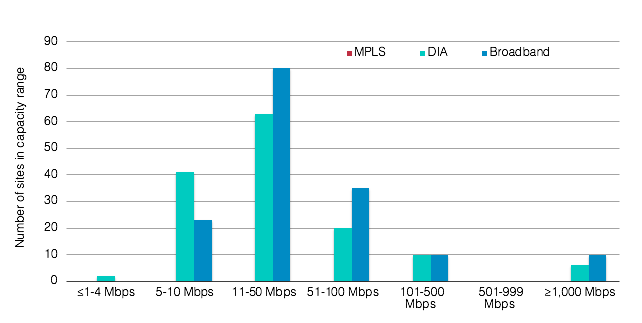
On-Net DIA-Broadband Hybrid WAN Average Total Site Capacity by Subregion
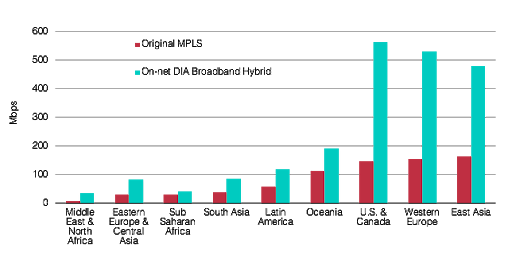
Broadband & SD-WAN
Finally, let’s look at the most radical network model: diving into the public internet with dual broadband connections. This is often the example cited when discussing SD-WAN’s cost-saving power. But there are two sides to this coin; you’re giving up a lot by going with an all-internet WAN. There are many performance and security-related reasons why an enterprise would hesitate to go in this direction.
The parameters of this network:
- We kept DIA at the large-capacity headquarters and data center sites for additional reliability and performance.
- Most circuits, like all other networks we saw, still fall into the 11-50 Mbps. But keep in mind if there are, for example, two 20 Mbps broadband circuits at a site, that means 40 Mbps of active capacity.
- The global average site capacity for this network comes to 502 Mbps, which is a 300% increase over our original MPLS network.
- Most subregions have an average site capacity of under 200 Mbps. However, the U.S. & Canada, Western Europe, and East Asia have massive averages due to headquarters and data center sites that might have two GigE connections or something close.
How does bandwidth change with dual broadband links?
Dual Broadband Hybrid WAN Site Capacity Range
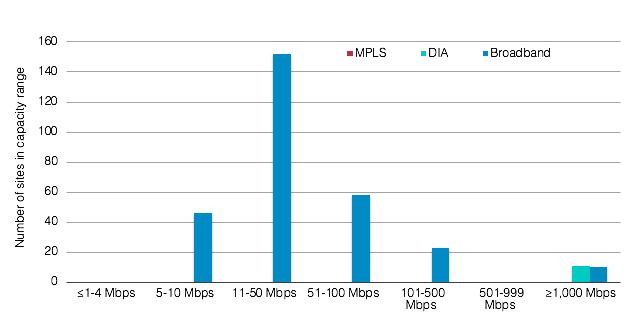
Dual Broadband WAN Average Total Site Capacity by Subregion
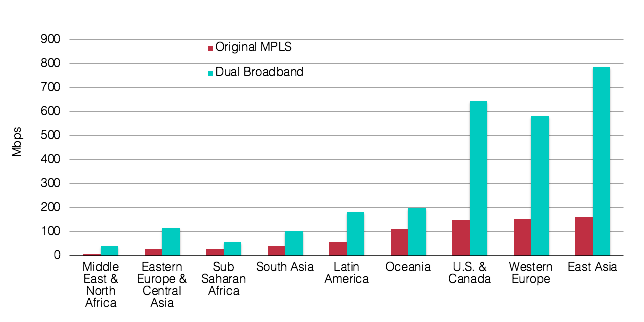
Comparing Costs
Time for the moment of truth. We have seen how reducing or getting rid of MPLS can dramatically increase available bandwidth, but what is the effect on network spend?
First, some things to note about our pricing model:
- The SD-WAN costs are based on non-recurring costs for installation or equipment, software license fees, number of controllers for the network, and monthly recurring costs for encrypted throughput at each site.
- As bandwidth increases, the cost of the SD-WAN overlay will also increase, but not significantly so.
- Access can account for 25-75% of the total cost of DIA at a site. Where feasible, I have assumed that DIA is “on-net,” meaning that the network provider has a presence in the site’s building and sells DIA without a separate access line charge. In total, 25 sites—those in Africa or considered remote sites—still have separate access costs.
Can adopting SD-WAN allow you to cut costs by 50% or more?
Original MPLS, MPLS-Core On-net DIA-Broadband, On-net DIA-Broadband, and Dual Broadband with Unmanaged SD-WAN Annual TCOs
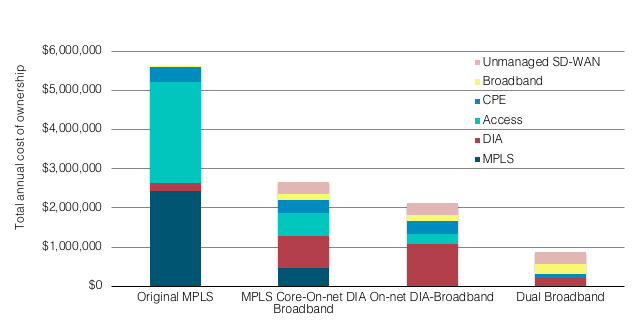
All of our scenarios are significantly cheaper than the original MPLS network.
The MPLS-core network found savings of 52% compared to the original MPLS network.
The on-net DIA-broadband network had savings of 62% compared to the original network.
The dual broadband network had savings of 84% of the original MPLS network. That’s not even cutting network spend in half. That is cutting network spend in fourths.
From a cost perspective, I would consider this myth confirmed.
I should point out that there are plenty of enterprises that roll-out SD-WAN without getting rid of MPLS. Some reduce MPLS from two active lines to one with DIA or broadband as a secondary line. While you may not see the dramatic savings that were demonstrated here, you can still capture some of the flexibility and network performance improvements of SD-WAN with a more conservative approach.
But if you’re willing to take on the risks, you can greatly increase your available bandwidth while saving money.
Catch up on more WAN Mythbusting:
- Is Local Access 50% or More of the WAN?
- Is MPLS Priced Like DIA?
- Do Tier 1 Carriers Charge More for DIA?
Elizabeth Thorne
Elizabeth Thorne was formerly a Senior Research Analyst at TeleGeography. Her work was focused on enterprise network research.





